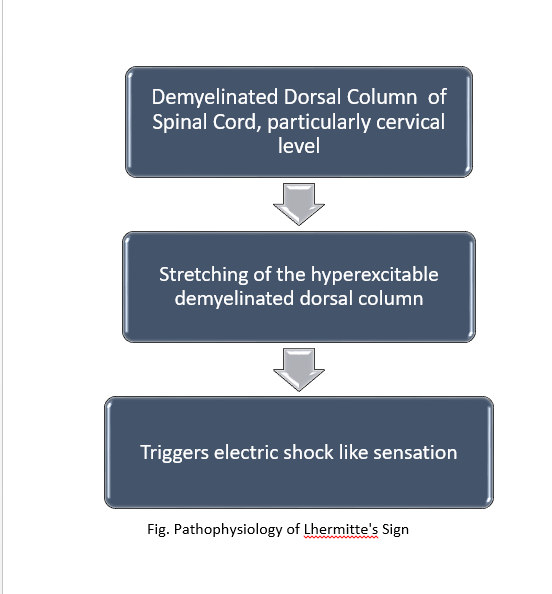Lhermitte's Sign
Original Editor - Shristi Maharjan
Top Contributors - Shristi Maharjan and Kim Jackson
This article is currently under review and may not be up to date. Please come back soon to see the finished work! (25/11/2021)
Introduction[edit | edit source]
Lhermitte's Sign is also known as "Lhermitte's Phenomenon", or also referred to as "Barber Chair Phenomenon". It is described as a transient sensation of an electric shock extending down the spine and/or extremities upon flexion of the neck, often a sequela of neurologic disease.[1] In this condition, upon the flexion of the nape, the sharp shooting sensation radiates down the spine, often into the upper and lower extremities, and sometimes to the trunk.[2] It only lasts for short period of time. It results from the stimulation of irritated nerves or the spinal cord and causes a similar sensation/irritation to hitting the elbow.[3] Lhermitte's sign can also be described as a symptom, as it is spontaneously explained by patients, on their own.[4] It is often one of the symptoms that people mention when they’re first diagnosed with multiple sclerosis.[5]
History[edit | edit source]
Lhermitte's sign was first described by Marie and Chatelin in 1917. The first reference to the symptom was described by Beriel and Devic in 1918 in multiple sclerosis (MS). In 1924, Lhermitte et al. described in detail a patient with MS and electric dysesthesias.[2] Jacques Jean Lhermitte, a forefather of modern clinical neurology, was a French neurologist conducting the majority of his research between 1908 and 1957. Lhermitte was famously recognized for his eponymously named “Lhermitte’s sign.”[6] Lhermitte's sign has been associated with the intensity-modulated radiotherapy (IMRT) for head and neck cancer patients. It is one of the late term effects following IMRT in these patients.[7]
Pathophysiology[edit | edit source]
Causes[edit | edit source]
Diagnosis[edit | edit source]
Validity[edit | edit source]
References[edit | edit source]
- ↑ Teoli D, Rocha Cabrero F, Ghassemzadeh S. Lhermitte Sign. 2021 Jun 29. In: StatPearls [Internet]. Treasure Island (FL): StatPearls Publishing; 2021 Jan–. PMID: 29630289.
- ↑ 2.0 2.1 2.2 Khare S, Seth D. Lhermitte's sign: the current status. Annals of Indian Academy of Neurology. 2015 Apr;18(2):154.
- ↑ Eske Jamie, Hammond Nancy, MD. What is Lhermitte's sign? MedicalNewsToday. March 17 2021
- ↑ Garcia-Moreno JM, Izquierdo G. Lhermitte's sign. Neurologia (Barcelona, Spain). 2002 Mar 1;17(3):143-50.
- ↑ Brown Tracy, Melinosky Christopher. Lhermitte’s Sign: What Is It? How Do You Treat It? WebMD. July 23 2020
- ↑ Chu DT, Hautecoeur P, Santoro JD. Jacques Jean Lhermitte and Lhermitte’s sign. Multiple Sclerosis Journal. 2020 Apr;26(4):501-4.
- ↑ Pak D, Vineberg K, Feng F, Ten Haken RK, Eisbruch A. Lhermitte sign after chemo-IMRT of head-and-neck cancer: incidence, doses, and potential mechanisms. International Journal of Radiation Oncology* Biology* Physics. 2012 Aug 1;83(5):1528-33.







